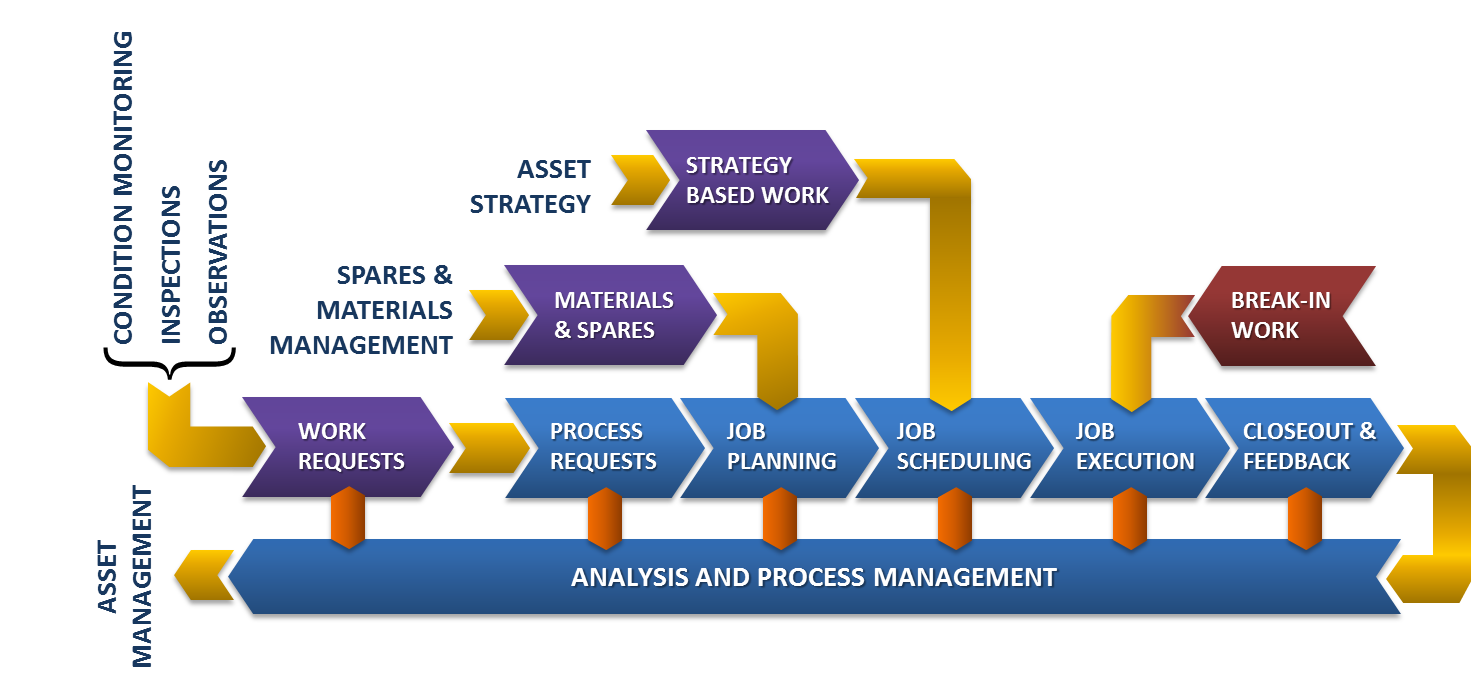Maintenance Reliability Transformation [MRT] in Detail
This page explains, in detail, the benefits of Maintenance Reliability Transformation
Stop the failures.
Can you imagine what it would be like to suffer fewer failures? What if you came to work and the day wasn’t destroyed by equipment failures and poor performance? What if people did not have to come in during the night or the weekend to get equipment up and running again? And what if there were fewer injuries when work was rushed due to those failures?
If you have investigated “asset management” or “reliability improvement” you just may feel like the goals are a little unrealistic. It may all appear overwhelming – so much to learn, so much to do, all while you are still suffering failures.
Focus on regaining control
Rather than shooting for the stars, it is time to focus on what is most important right now – making the necessary changes so there are fewer failures. No unexpected failures. No rework. All work calmly planned and scheduled.
That is what the Maintenance Reliability Transformation [MRT] process was designed to do; it will enable you to “Break out of the reactive maintenance cycle of doom”. Yes, it is a melodramatic description, but the endless cycle of failures and frustration will never end unless you eliminate the reasons why equipment fails, and you perform the necessary work efficiently and cost effectively.
No, you can’t replace the equipment with uber-reliable alternatives. No, you can’t employ more maintenance technicians. No, you can’t do anything about the design and purchasing decisions that lead to many of the failures. And you probably can’t change the way the equipment is operated – for now.
Focus on what you can control
So, we need to focus on what you can change: the way you manage spares; the way you plan, prioritize, and schedule the repairs and installations; the way the maintenance tasks are performed; and the way you care for the equipment, spares, workshop, and people.
You will do the right work at the right time, and everyone will do it the same way – and that will be the right way. You will use condition monitoring so you can plan and schedule the work, and you will stop performing the maintenance tasks that waste time and cause failures to occur.
But you may be wondering, doesn’t all that sound like “world-class” maintenance? The reality is that, for now, we plan to be “good” in all those areas, not “excellent”. Too many programs fail because they shoot for the stars, or they become overwhelmed with all the jargon, acronyms, and methods like RCM, RCA, and many others and never really get started. We will “just” focus on getting the fundamentals right – one step at a time.
And hey, when things are under control you can reset your goals and shoot for the stars and achieve the gold-standard, world-class, A1 maintenance and reliability. The Asset Reliability Transformation (ART) process will help you do that – but not yet.
How will you regain control?
Our process provides the guidance you need in all the core areas. You will:
- Assess your current strengths and weaknesses so you know where you stand. We’ll provide a tool to help you do that.
- Build relationships: Once you have a maintenance manager in place, it is essential to build a strong relationship with operations/production so everyone is on the same page pulling in the same direction. We include presentations you can use to create awareness.
- Establish the fundamentals: a functioning CMMS, an accurate spares and master asset list, an organized storeroom, and more.
- Determine how to prioritize your activities with basic “criticality analysis” and a “bad actor” list – focus your time on the 20% of assets that cause the downtime, overtime, maintenance expense, etc. We’ll provide a tool to help you do that.
- Review the maintenance tasks being performed: some waste your time, some harm your equipment, and some are missing – we’ll guide you through that process.
- Establish the fundamentals of planning and scheduling: organized and efficient – the right person doing the right job at the best time with minimal waste.
- Organize and improve the storeroom so parts/spares/materials are available, and they come off the shelf in “perfect” condition.
- Ensure the equipment is set up for success with precision alignment, fastening, and balancing, and it remains in that state with precision lubrication and cleaning.
- Get a view of the future with condition monitoring so the work can be planned and the root causes of failure can be identified and eliminated before they result in failure.
Yes, there are a few things to do, but we have broken it up into 78 smaller steps, all described in detail, so you can pick them off one by one.
To break out or not to break out…
Where will you be in a year? Will you still be frustrated at the failures, costs, and lost opportunities, or in control, proud of your achievement, and working in a plant that is not always responding to the next incident?
If you would like to know more, please read the section on how the training program guides you through the 12 steps and 78 recommended practices.
Or if you are ready to take the next step, you can learn the Maintenance Reliability Transformation [MRT] process as you take your time and own the training so that it can guide you through the steps while you are performing them [MRT Solo package] or you can take the best option – the MRT Team package allows you to invite up to nine other people to learn about the process and/or take “awareness training” so they understand what we are trying to achieve. You will be more successful if you involve the entire maintenance department (and operations/production, engineering, and others).

